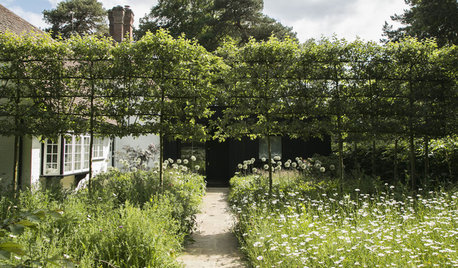Poor apple trees...
mulberryknob
11 years ago
Related Stories

EDIBLE GARDENSHow to Add an Apple Tree to Your Edible Garden
Readily available, beautiful and fragrant, apple trees offer four-season interest along with crisp, juicy fruit
Full Story
GARDENING AND LANDSCAPINGCrab Apple Trees Set Off a Stylish English Courtyard
A structure of pleached crab apple trees, bordered by a wildflower meadow, links a minimalist addition to an old house in Buckinghamshire
Full Story
EDIBLE GARDENSHow to Grow 10 Favorite Fruit Trees at Home
Plant a mini orchard in fall, winter or early spring to enjoy fresh-off-the-tree fruit the following year
Full Story
GARDENING AND LANDSCAPINGCrazy for Fruit Trees
Whether a single citrus or a mini apple orchard, even the smallest landscape space can bear deliriously delicious fruit
Full Story
GARDENING GUIDESHow to Keep Your Citrus Trees Well Fed and Healthy
Ripe for some citrus fertilizer know-how? This mini guide will help your lemon, orange and grapefruit trees flourish
Full Story
SIDE YARD IDEASNarrow Trees for Tight Garden Spaces
Boost interest in a side yard or another space-challenged area with the fragrance and color of these columnar trees
Full Story
CHRISTMASReal vs. Fake: How to Choose the Right Christmas Tree
Pitting flexibility and ease against cost and the environment can leave anyone flummoxed. This Christmas tree breakdown can help
Full Story
LANDSCAPE DESIGNFlood-Tolerant Native Trees for Soggy Soil
Swampy sites, floodplains, even standing water ... if you've got a soggy landscape, these trees are for you
Full Story
LANDSCAPE DESIGNThe Unparalleled Power of Trees
Discover the beauty and magic of trees, and why a landscape without them just isn't the same
Full Story
GARDENING GUIDES10 Top California Native Plants, Trees and Grasses
Enjoy a fuss-free, water-wise garden in the Golden State by growing plants naturally in tune with the climate and wildlife
Full StorySponsored
More Discussions






Okiedawn OK Zone 7
OklaMoni
Related Professionals
Londonderry Landscape Architects & Landscape Designers · New Bedford Landscape Architects & Landscape Designers · Broadlands Landscape Contractors · Eustis Landscape Contractors · Midland Landscape Contractors · Oxnard Landscape Contractors · South Lake Tahoe Landscape Contractors · Sugar Hill Landscape Contractors · White Bear Lake Landscape Contractors · Blue Springs Decks, Patios & Outdoor Enclosures · Green Bay Decks, Patios & Outdoor Enclosures · Knoxville Decks, Patios & Outdoor Enclosures · Norman Decks, Patios & Outdoor Enclosures · Towson Decks, Patios & Outdoor Enclosures · West Chicago Decks, Patios & Outdoor Enclosuressoonergrandmom
chickencoupe
Okiedawn OK Zone 7
slowpoke_gardener